When you’re in the market for a utility terrain vehicle (UTV), you might have encountered two prominent names that stand out due to their performance and reliability: the Can-Am Defender and the Honda Pioneer. These two models are well loved in the powersports community for various reasons, including their utility, durability, and the fun factor they bring to the table for off-roading adventures. As someone keen on making an informed choice, you might find yourself comparing these two side by side to determine which one best suits your needs.

The Can-Am Defender is famed for its robust towing capabilities and powerful engine options. Some models offer up to 3,000 lbs. of towing capacity and engine sizes reaching up to 976cc. On the other side, the Honda Pioneer holds its ground with a considerable engine size too. While its towing might not reach the heights of the Defender, it still offers a solid performance that many find appealing. However, what distinguishes them further are features like passenger capacity and fuel economy, aspects that might significantly influence your final decision.
The Can-Am typically starts at a higher base price than the Honda, but each brand has a variety of trims that can match your budget and specific requirements. Whether it’s for work or play, both UTVs have their advantages and it ultimately boils down to what features you prioritize. Is it the power and towing capacity, the price point, or perhaps the fuel economy and comfort during your rides? Keep these comparisons in mind as you navigate through the nitty-gritty details of each model.
Overview of Can-Am Defender vs Honda Pioneer Comparisons
Your quest for the ideal off-road companion may lead you to consider the Can-Am Defender and Honda Pioneer. These side-by-side vehicles are staples in the industry, each with a unique heritage, robust market presence, and a specific audience that swears by their capabilities.
Brand Heritage
Can-Am Defender
- Manufacturer: BRP (Bombardier Recreational Products)
- Known for: Versatility and power in utility vehicles.
Honda Pioneer
- Manufacturer: Honda
- Known for: Reliability and innovation in the powersports industry.
Market Position
Can-Am Defender
You’ll find the Defender holding a strong position, recognized for its towing capacity, which reaches up to 3,000 lbs, and engine size options like the 900cc class, offering robust choices for heavy-duty tasks.
Honda Pioneer
The Pioneer is equally respected, with its base models starting at a price point comfortable for many budgets. Despite having slightly less towing capacity at 1,500 lbs, it boasts a reliable build quality and engine size up to 999cc, holding on to a competitive spot in the market.
Target Audience
Can-Am Defender
You’re likely part of the Defender’s audience if you need a high-performance UTV for intense utility work, long rides on challenging terrains, or if you’re attracted to customizations that add to its versatility.
Honda Pioneer
If you’re aiming for longevity, dependability, and a bang-for-your-buck value, the Pioneer will attract you. It’s tailored for both recreational riders and professionals who need a hardworking side-by-side that won’t quit on tough jobs.
Design and Comfort
When considering a UTV, you’ll want to ensure that both the design and comfort meet your needs. Let’s take a closer look at how the Can-Am Defender and Honda Pioneer stack up in these areas.
Exterior Aesthetics
Can-Am Defender: Your visual experience with the Defender kicks off with its modern angular shape that includes a bold front grille design. The Can-Am seems to edge towards a more aggressive look.
Honda Pioneer: In contrast, the Pioneer opts for a classic UTV appearance that’s boxier with a flat front end, projecting a more traditional and utilitarian appeal.
Interior Cabin Features
The interior cabin of the Can-Am Defender flaunts a dashboard replete with intuitive controls and a touch of modern refinement that may appeal to those who prefer a tech-forward environment. The Honda Pioneer’s cabin, on the other hand, is straightforward and functional, emphasizing durability and ease of use.
Seating and Legroom Comfort
- Can-Am Defender: Boasts adjustable seats and ample legroom, making your rides comfortable, especially on longer journeys.
- Honda Pioneer: Provides seating that is designed for utility and may feel more firm, but still puts a premium on ensuring you have enough space to move and not feeling cramped.
Storage Space and Convenience
Storage space is crucial for UTV enthusiasts, and here’s how these two fare:
- Can-Am Defender: Offers ample storage options with a versatile cargo bed and additional storage compartments for tools, gear, and personal items.
- Honda Pioneer: While slightly behind in sheer volume, the Pioneer makes intelligent use of its space with a respectable cargo bed and multiple storage solutions to keep your essentials secure.
Engine and Performance
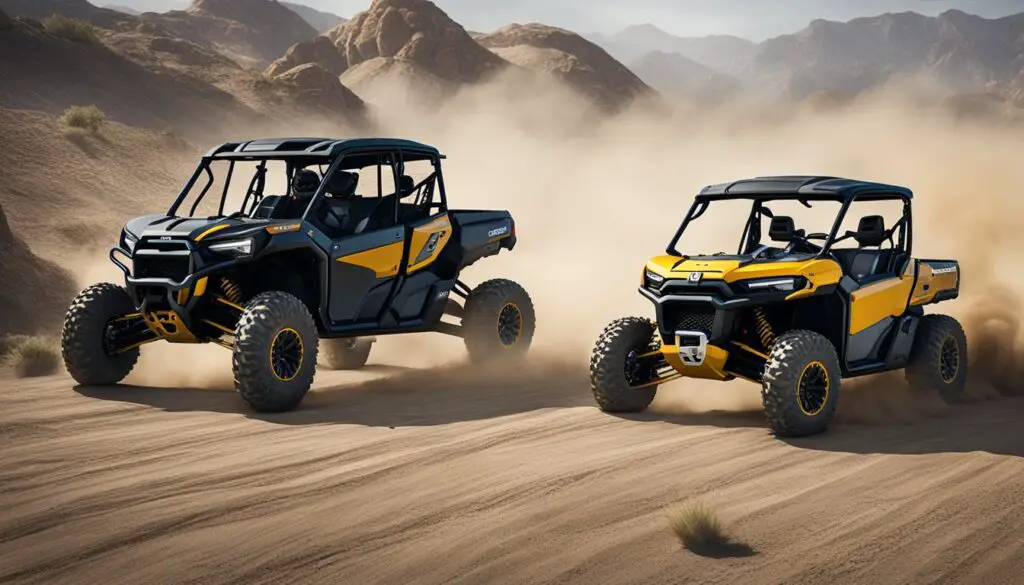
In considering the Can-Am Defender and Honda Pioneer, you’ll find distinct differences in their engines and performance capabilities, which are pivotal factors for any utility task vehicle (UTV).
Engine Specifications
The Can-Am Defender comes equipped with a Rotax ACE 976cc engine. This is a liquid-cooled power plant recognized for robust performance. Meanwhile, the Honda Pioneer is powered by a 999cc liquid-cooled engine, which, while slightly larger in size, offers different performance characteristics.
- Can-Am Defender: 976cc Rotax engine
- Honda Pioneer: 999cc engine
Performance Metrics
When you look at the performance metrics, consider the power each engine delivers. The horsepower (HP) of each vehicle indicates the pure muscle you have at your disposal:
- Can-Am Defender: Approximately 52HP
- Honda Pioneer: HP not specified in the provided data.
Power and Torque
The torque figures of these vehicles are another window into their performance, although the specifics have not been provided in the given data. Torque translates directly to the pulling power, especially important for a UTV when you’re traversing tough terrains.
Towing and Payload Capacity
The towing and payload capacities are where you clearly see the differences between these two UTVs. The Can-Am Defender excels with a significantly higher towing capacity, which makes it a powerhouse for hauling heavy loads.
- Can-Am Defender: Up to 3,000 lbs towing capacity
- Honda Pioneer: Up to 1,500 lbs towing capacity
Handling and Drivability
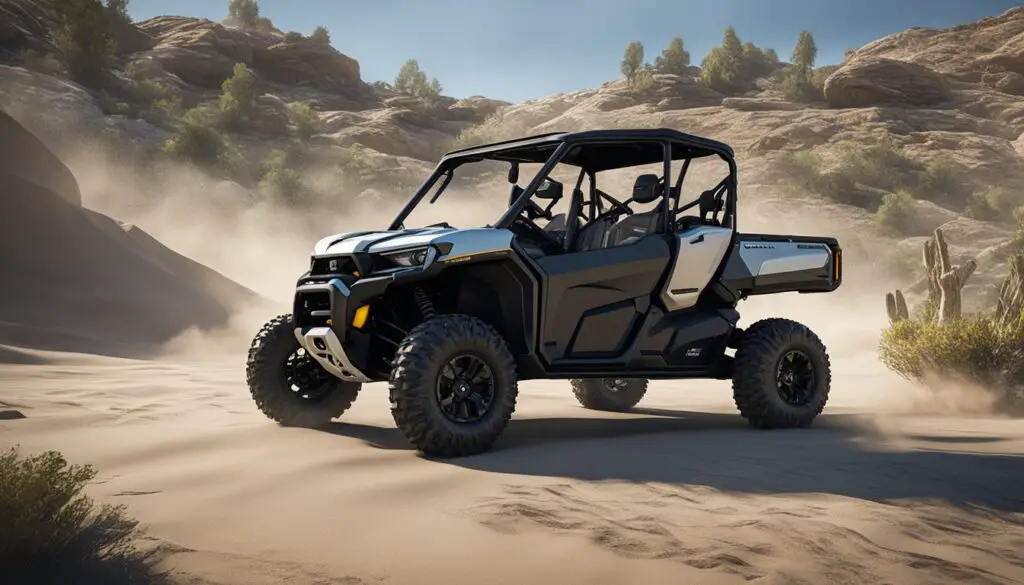
When considering the Can-Am Defender and Honda Pioneer, handling and drivability are crucial elements of your off-road experience. Factors like suspension, transmission, and brakes play significant roles in how these vehicles perform, especially on challenging terrains.
Suspension System
The suspension system influences your ride’s comfort and the vehicle’s stability. In the Honda Pioneer, expect a durable independent suspension that provides a solid ride over rough terrain. Meanwhile, the Can-Am Defender boasts a dynamic suspension setup that adjusts to varying loads and conditions, enhancing your comfort and control.
Transmission and Driving Modes
The transmission and driving modes determine the versatility of your vehicle. The Honda Pioneer features a user-friendly automatic transmission that smoothly transfers power, making it easier for you to focus on the trail. The Can-Am Defender’s transmission includes standard, work, and performance driving modes, offering you options to tailor your ride to the current terrain or task.
- Honda Pioneer: Automatic Transmission
- Can-Am Defender: Multiple Driving Modes
Brakes and Safety
A reliable braking system ensures safety and precision stopping power. Both the Honda Pioneer and Can-Am Defender are equipped with hydraulic disc brakes that provide confidence-inspiring stopping ability. For added safety, pay attention to the vehicle’s inherent stability and available safety features designed to protect you in various conditions.
Terrain Adaptability
Your command over various terrains comes down to the machine’s adaptability. The Honda Pioneer offers a respectable approach to terrain management, capable of handling both smooth trails and more challenging conditions. The Can-Am Defender, however, shines in its ability to conquer tougher, more uneven landscapes with ease, thanks to its responsive handling and robust design.
Features and Technology
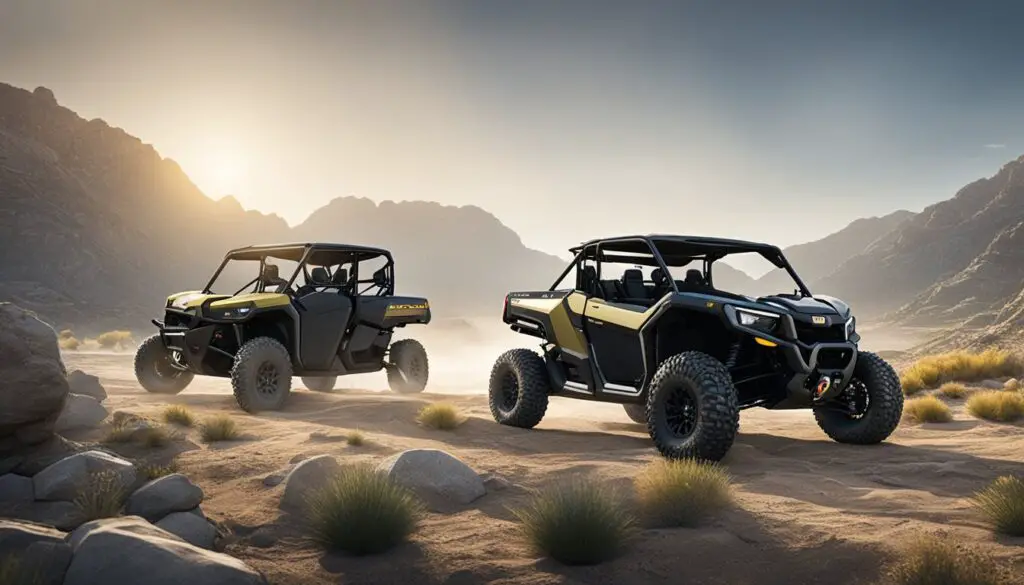
When you’re comparing the Can-Am Defender and the Honda Pioneer, you’ll find that they both have advanced features aimed at enhancing your riding experience. Let’s take a look at how they stack up in terms of digital interfaces, customization options, and the technologies designed for comfort, convenience, and safety.
Digital Display and Controls
The Can-Am Defender boasts a digital display that provides critical vehicle information at a glance, ensuring you stay informed of your vehicle’s performance. Controls are intuitively placed for ease of use even on rough terrain. The Honda Pioneer doesn’t lag behind, offering a digital meter that complements the vehicle’s modern and rugged feel, giving you access to vehicle diagnostics and other essential data.
Adjustable Features
Both the Defender and the Pioneer cater to your need for customization:
- The Defender has tilt steering wheel adjustments, so you can set the perfect position for control and comfort.
- The Pioneer also offers adjustable seating and steering configurations, though the specifics may vary by model and trim.
Comfort and Convenience Technologies
For comfort and handling, both models come equipped with electric power steering, which not only makes navigating challenging environments easier but also reduces fatigue during longer rides.
- Can-Am Defender:
- Cargo Bed: Enhanced with a versatile, multifunctional cargo box.
- Hill Descent Control: Allows for smooth, controlled descents on steep inclines.
- Honda Pioneer:
- Cargo Bed: Integrates with Honda’s innovative QuickFlip® seating for additional passenger space.
Safety and Utility Enhancements
Safety is paramount in the design of both UTVs, with each offering unique features to enhance protection and utility:
- The Defender’s one-way tire pressure monitoring system is a standout.
- The fuel economy of the two vehicles is comparable, with the Defender offering up to 28 mpg and the Pioneer up to 25 mpg, depending on driving conditions and maintenance.
Price and Value for Money
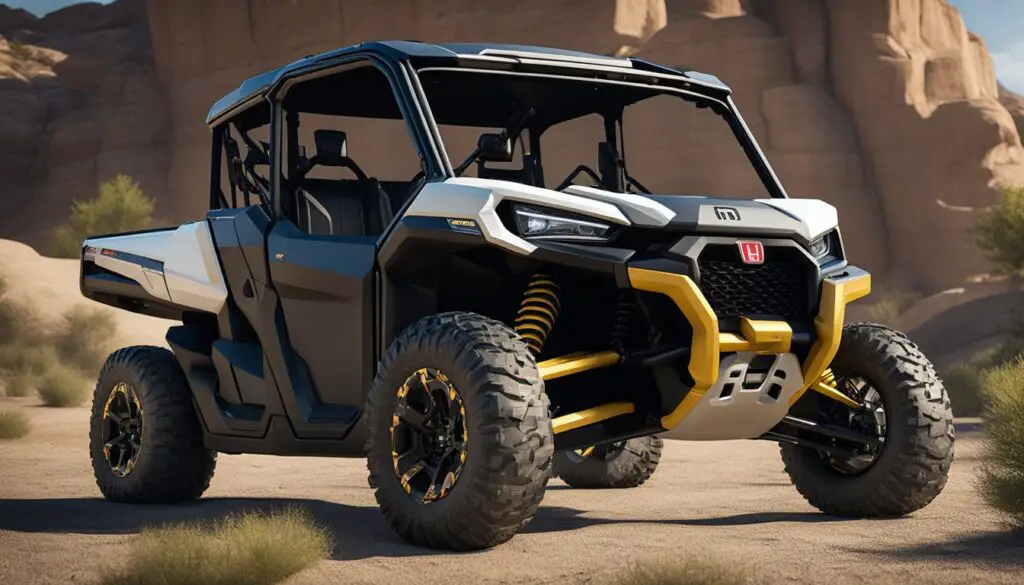
When considering a utility vehicle like the Can-Am Defender or the Honda Pioneer, you’ll want to factor in the base model’s price as well as what you’ll get when you opt for upgraded models. It’s also important to consider the warranty and after-sales services provided by both brands, and the overall cost related to ownership over time.
Base Model vs. Upgrade Options
Honda Pioneer: The base model costs around $15,899 MSRP, providing a solid build and essential features for utility tasks. Can-Am Defender: Starts at a slightly lower price point with a $14,099 MSRP for its base variant, offering a range of upgrade options that allow you to customize your vehicle to your specific needs.
| Model | Starting MSRP | Features Included in Base Model | Upgrade Options Available |
|---|---|---|---|
| Honda Pioneer | $15,899 | Standard utility features | Yes, various trims |
| Can-Am Defender | $14,099 | Standard utility features | Yes, extensive trims |
Warranty and After-Sales Service
When you invest in a Honda Pioneer, you’re backed by Honda’s reputation for reliability and a competitive warranty program. Can-Am also provides a solid warranty for the Defender, ensuring you get the support needed if there are any issues. Both brands offer extensive dealer networks for service, ensuring you have the support you need wherever your adventures take you.
Cost of Ownership
The cost of owning your utility vehicle encompasses more than just the initial price tag. The Can-Am Defender is known for its fuel efficiency and a one-way tire pressure monitoring system, which can help lower fuel costs. Maintenance expenses, insurance, and potential repair costs contribute to the overall cost of ownership, making it imperative to consider longevity and durability alongside the purchase price.
Off-Roading Capabilities
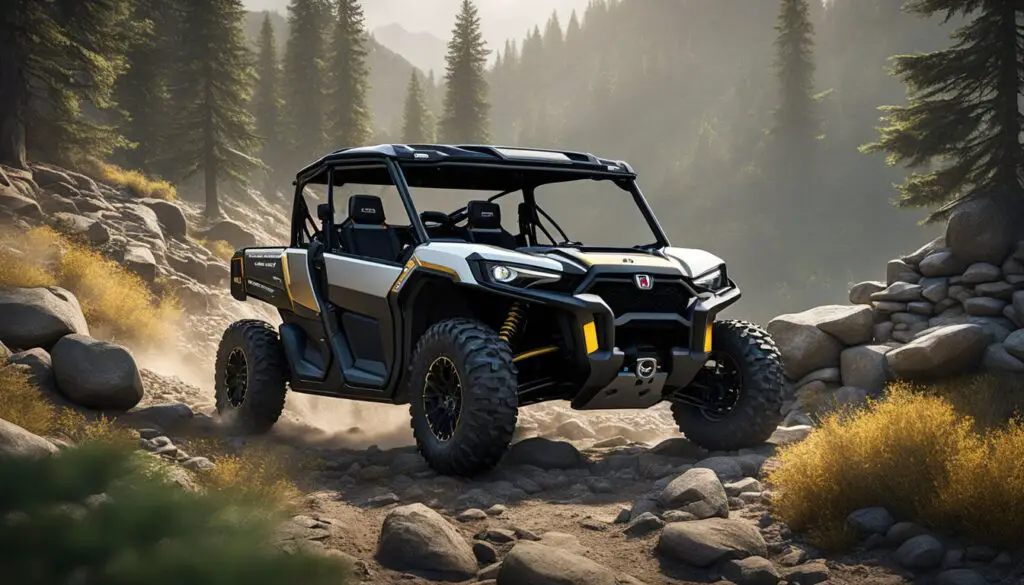
When you’re considering the off-roading capabilities of the Can-Am Defender and Honda Pioneer, it’s crucial to look at the effectiveness of their 4WD systems, the purpose-built features for off-road use, and how they perform across various terrains.
4WD and Differential Locks
The Can-Am Defender offers versatile 4WD with a Visco-Lok auto-locking front differential that progressively transfers power from wheels that slip to those that grip. This ensures better traction when you’re dealing with challenging conditions. On the other hand, the Honda Pioneer makes use of a 4WD system complemented by a manually activated differential lock that provides solid traction on rough terrain but requires you to anticipate the need and engage it.
Off-Road Vehicle Features
Can-Am Defender: Your experience is enhanced with features like the Dynamic Power Steering (DPS) for a more responsive handling, and it boasts a substantial ground clearance and a protective underbody.
- Ground Clearance: 12 inches
- Underbody Protection: Full HMWPE skid plate
The Honda Pioneer isn’t left behind in features. It’s designed with ample ground clearance and a protective undercarriage to handle off-road abuse without taking damage to vital components.
- Ground Clearance: 10.5 inches
- Underbody Protection: Standard skid plate
Performance in Different Terrains
Your Can-Am Defender is ready for virtually any terrain with its hearty engine and intelligent Throttle Control (iTC), offering different throttle responses for different riding conditions. Its torque and larger engine size facilitate climbing steep inclines and navigating rough landscapes.
The Honda Pioneer maintains your momentum with a well-balanced suspension system and a reliable engine that will power you through most terrains. While it may not have the same raw power as the Defender, it provides consistent performance that many off-road enthusiasts appreciate.
Utility and Practicality
When choosing between the Can-Am Defender and Honda Pioneer for utility purposes, consider how they can help you accomplish your tasks with their cargo box attributes, towing proficiency, and suitability for work applications.
Cargo Box Attributes
Can-Am Defender:
- Capacity: Up to 1,000 lbs in the cargo bed.
- Features: Versatility for carrying both small and heavy loads, suitable for farm work or recreational use.
Honda Pioneer:
- Capacity: Up to 1,000 lbs as well, though some models may offer less.
- Features: The cargo box is designed for practical use, supporting day-to-day tasks with ease.
Towing Proficiency
Can-Am Defender:
- Towing Capacity: Up to 3,000 lbs, allowing you to move heavy equipment or supplies without trouble.
Honda Pioneer:
- Towing Capacity: Generally up to 1,500 lbs, ideal for smaller towing jobs around the property.
Work Applications
Can-Am Defender and Honda Pioneer: Both are categorized as Utility UTVs, with the robust construction necessary for handling rugged environments and assisting with various tasks.
- Suitable for farms, they can navigate through rough terrain while carrying tools, supplies, or produce.
- Their payload capacities ensure that you can transport whatever is necessary for your work, within the respective limits of each model.
Choosing between these two may come down to the specific needs of your farm, property, or recreational pursuits.
Comparison and Final Thoughts
In the face-off between the Can-Am Defender and the Honda Pioneer 1000 Deluxe, you’ll want to consider the detailed specs and how each model aligns with your needs. Let’s take a direct look at how these two stack up.
Side-by-Side Specs Contrast
| Specification | Can-Am Defender | Honda Pioneer 1000 Deluxe |
|---|---|---|
| Engine Size | 976cc | 999cc |
| Horsepower | 52 HP | Not Publicly Listed |
| Towing Capacity | Up to 3,000 lbs | Up to 1,500 lbs |
| Cargo Bed Capacity | Comparable (1000 lbs+) | Comparable (1000 lbs+) |
| Price (Base Model) | ~$14,099 (as of 2023) | ~$15,899 (as of 2023) |
| Weight | 1,471 lb (667 kg) | 1,595 lb |
| Fuel Economy | Up to 28 mpg | Up to 25 mpg |
Pros and Cons
Can-Am Defender
- Pros: Larger engine size and superior towing capacity can handle tough tasks with ease. It offers better fuel economy and a more accessible base price point.
- Cons: It might provide more power than necessary for casual users, which could mean an unnecessary trade-off in terms of fuel costs if not utilized fully.
Honda Pioneer 1000 Deluxe
- Pros: High cargo bed capacity and a robust engine. The Pioneer 1000 Deluxe is well-suited for both work and recreation.
- Cons: Higher base price and less towing capacity might limit its versatility compared to the Defender.
Overall Winner and Summary
When comparing specs, the Can-Am Defender leads with a more powerful towing capability and a larger engine. However, if the vehicle’s weight and price are significant factors for you, the Honda Pioneer 1000 Deluxe’s slightly higher weight and cost should be considered. Both vehicles offer comparable cargo bed capacities, which is often a crucial aspect for utility tasks.
In terms of value, your preference for either brand may tip the scales. The Defender’s fuel economy and initial cost may appeal to you if you’re budget-conscious, while the Honda’s brand reputation for reliability might influence your decision if long-term use and dependability are your top priorities.
Choosing a winner comes down to specific needs. For rigorous towing and cost-effective operation, the Can-Am Defender takes the lead. But for brand enthusiasts who might prioritize a robust engine and are less concerned with towing, the Honda Pioneer 1000 Deluxe is a solid choice. Evaluate your requirements, and let them guide you to the vehicle that fits best with your intended usage.
Frequently Asked Questions
Navigating through the choices between the Can-Am Defender and Honda Pioneer can be quite intriguing, especially when you want to make an informed decision. Here’s a simple breakdown of what you might be curious about regarding these two competing UTVs.
What are the main differences in specifications between the Can-Am Defender and the Honda Pioneer?
The Can-Am Defender offers a larger maximum engine size of 900cc compared to the Honda Pioneer, which has a max engine size of 700cc. Additionally, the Can-Am Defender has a higher towing capacity of up to 3,000 lbs, while the Pioneer can tow up to 1,500 lbs.
How does the Honda Pioneer 1000 compare to the Can-Am Defender in terms of performance?
The Honda Pioneer 1000 features a 999cc engine and offers a fuel economy of up to 25 mpg, while the Can-Am Defender comes with a 976cc engine and boasts a fuel economy of up to 28 mpg. The Defender also has tire pressure monitoring to enhance fuel efficiency and ride smoothness.
Where can I find a comparison discussion between the Can-Am Defender and the Honda Pioneer?
For an in-depth comparison discussion, enthusiasts and prospective buyers commonly turn to online forums, social media groups dedicated to UTVs, and reviews on off-roading websites.
What are the pros and cons of the Can-Am Defender versus the Honda Pioneer according to current owners?
Current owners often praise the Honda Pioneer for its reliability and value. The Can-Am Defender, priced starting at $14,099, is noted for its higher towing capacity and larger engine. However, every owner may weigh these aspects differently based on personal needs.
What updates were made to the Can-Am Defender and Honda Pioneer in the 2021 models?
Updates to the 2021 models of both UTVs included enhancements in ride comfort, engine performance, and user convenience features. Specific details may vary between different trims and configurations.
How do the capacities of the Can-Am Defender Max and Honda Pioneer 1000-6 differ?
The Can-Am Defender Max has an impressive cargo bed and passenger capacity when compared to the Honda Pioneer 1000-6, which also offers a respectable payload capacity. However, the Pioneer may fall slightly behind in towing and payload capacity figures in comparison.
Leave a Reply